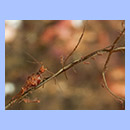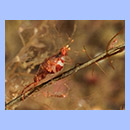- Kingdom: Animalia
- Phylum: Arthropoda
- Subphylum: Crustacea
- Class: Malacostraca
- Subclass: Eumalacostraca
- Superorder: Peracarida
- Order: Amphipoda
- Suborder: Corophiidea
- Family: Dulichiidae
- Scientific name: Dyopedos sp.
- Norwegian: -
With permission from T. Cedhagen. From S. Mattson and T. Cedhagen (1989).
Characteristics:
D. monacantha and D. porrectus, especially the females, are easily confused. The body length of fully grown individuals range from 5 to 9 mm. Both species are pale yellow with brown blotches. A dominating feature is the four, hairy antennas. The first pair is approximately as long as the body length. The second pair is somewhat shorter, three fourths of the first pair. The last pair of legs are quite long and directed backwards, giving it a kneeling appearance. Details of the plates covering body and legs are used to distinguish these species. It is virtually impossible to make certain identifications from images alone.
Habitat:
Like spiders, these species build structures from spinning threads. They can be encountered on depths ranging from 15 to several hundred meters.They build long stems, where they watch for anything edible drifting by. The long antennas are used for food collection. The offspring tends to seek shelter in their mother's stem. If threatened by fish, they cling to the stem, making it difficult for the predator to nibble them off. S. Mattson and T. Cedhagen (1989) studied this behavior in an aquarium (see drawing).
Distribution:
This is most likely Dyopedos monacanthus or D. porrectus. These species are well known from the British Isles and the west coast of Sweden. There is little information on the distribution along the Norwegian coast.


